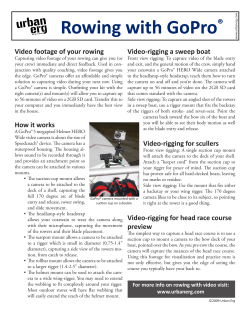
Infrared (IR) imaging technology
RDX0206INDIGO.qxd 6/11/02 4:34 PM Page 9 Thermography: Temperature measurement of an object by observation of its emitted radiation, primarily in the infrared waveband. ANALYTICAL INSTRUMENTS How to Measure the Temperature Of a Speeding Bullet Infrared (IR) imaging technology about 930 m/sec. We wanted to freeze the apparent offers a way to measure temperatures of objects motion of the bullet, so we chose the shortest integration that do not easily lend themselves to physical con- time (shutter speed) for this camera, which is 10 µsec. tact. All objects emit electromagnetic radiation, The bullet travels 9.3 mm in this time, about half of its primarily in the IR waveband for objects at terres- length. One can see a blurred “tail” to the bullet caused trial temperatures. One of the most useful wavebands by its motion. The camera has an indium antimonide for thermography is the midwave IR, or MWIR band. detector with a cold filter that results in a 3 to 5 m waveSmall changes in temperature produce large relative length sensitivity, and a 50 mm lens that was placed about changes in flux, leading to increased thermal contrast 1 m from the gun’s muzzle. over other IR wavebands, that in turns leads to more accuWe set up a digital data acquisition system to record rate temperature measurement. 600 frames of 12-bit digital image data at 60 frames/sec. The technique is as follows: A thermographically cal- We would then empty a 30-round magazine through the ibrated IR camera is pointed at an gun over the 10 sec recording object of interest and an image is time. We would go back through taken. Software takes the digital the sequence frame by frame to data from the detectors in the find images of the bullet emergcamera’s sensor and converts ing from the muzzle gas cloud. these data into temperature valThe bullets cooled as they travues. In a typical calibration proeled away from the gun. Any bulcedure, the camera is pointed at a let within the gas cloud is effecblackbody source at known temtively invisible to this camera. perature. The response of the Once we had located the best camera is repeatedly recorded as image in our data set, we measthe source temperature is varied ured the signal level average on over a range of interest for a spethe pixels right in the center of cific application, and a polynomithe bullet in the image. This sigal is fit to the data. This polynonal level was found to be 3,800 mial function can be used to digital counts out of a possible calculate the temperature of an 4,096. We then pointed the camobject for any temperature within This MWIR image shows a bullet that has era at a high-temperature cavity the range of the calibration. blackbody source that had a just emerged from the cloud, where the temThe camera lens itself can perature would be at its highest. A close-up copper penny placed inside of it. contribute to the flux of IR radia- of bullet shown in inset. The penny has a surface of oxition reaching the detector array. dized copper, and emits MWIR The lens contribution can be calibrated out at a particular light in a similar manner to a copper-jacketed bullet in temperature, but if the camera environment changes, then flight. When the penny temperature reached 267°C, the the apparent temperature of an object as viewed by the signal level averaged over a cluster of pixels within the camera can change. Therefore, a thermographic camera penny’s boundaries was the same as the signal level should have temperature sensors in the lens housing or from the bullet. lens interface itself, so that the software that calculates the This type of calibration is the most accurate way to temperature of a source compensates for the IR contribu- measure the temperature of an object that is not a pertion from the lens itself. fect blackbody emitter, as is the case with a bullet. We Recently, we measured the temperature of a rifle bul- concluded that the bullet’s temperature was around let in flight. This is an excellent 267°C. The bullet gets very hot as it example of an object whose temperis forced down the rifle barrel at WEB RESOURCES FOR THERMOGRAPHY: ature is impossible to measure with supersonic speeds. www.indigosystems.com —Austin Richards, PhD standard thermometers. The bullet http://htm29.ms.ornl.gov/tpuc/index.html Richards is the senior applications engineer at was a 5.56 mm NATO round (fired http://thermal.physics.wayne.edu/ Indigo Systems Corp. home/thermal.html from an AR-15 carbine) traveling at www.rdmag.com R&D Magazine, June 2002 9
© Copyright 2025





















